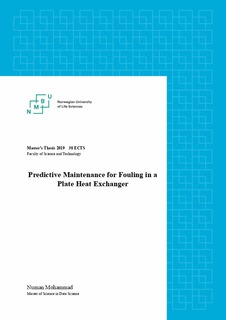| dc.description.abstract | Heat exchangers are very common in industrial processes, such as waste heat recovery and the food and chemical industry as well as in daily life like air-conditioning. One of the major hurdles in the performance, process, and operation of heat exchangers is fouling. Fouling can be of many types, but in the water industry, crystallisation fouling is one of the leading problems. Crystallisation fouling occurs on the surfaces of heat exchangers because of aqueous solutions containing a high concentration of magnesium and calcium ions. In this project, we applied machine-learning tools to make a predictive model. The purpose is to predict when crystallisation fouling is likely to accelerate and thereby reduce the performance of the heat exchanger, so early precautions can be taken to mitigate the fouling phenomenon or plan the future cleaning schedule to reduce the loss of production.
In order to collect data, a lab-scale setup of plate heat exchangers was prepared in which crystallisation fouling by Calcium carbonate (CaCO3) was allowed to occur. The setup was run from fouling-free to fully fouled operation of the heat exchanger, while the readings of the variables were recorded at an every-minute interval during the operation. It was found that the operation of the heat exchanger can be classified into three stages (i.e. no fouling, some fouling, and full fouling). These stages can also be predicted with high accuracy using machine learning tools.
Exploratory analysis by PCA emphasises the presence of hidden structures and patterns in the data, resulting in three clear clusters. These stages can be differentiated with high accuracy by both clustering and classification methods. Logistic regression was chosen as the algorithm for predictive modelling because of its attributes and performance.
Since the prediction of probabilities of the stages helps provide a good assessment of risks, logistic regression performed better in this regard. The pattern of probabilities of the no-fouling stage before the actual some-fouling stage indicates that precautions are required to avoid the some-fouling stage that can otherwise reduce the performance of heat exchangers. When the number of features in the data was reduced, the performance of logistic regression improved, indicating that some variables are causing noise in the prediction. Four features, cold-water exit, hot-water exit, POS, and speed were evaluated as important by feature importance permutation.
Our results emphasise that the data collected from the sensors can be used to predict when the heat exchanger is not working normally. The potential to build high-quality predictive models for fouling is encouraging despite various limitations in this work. | nb_NO |

